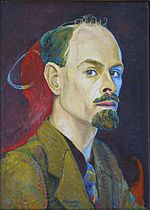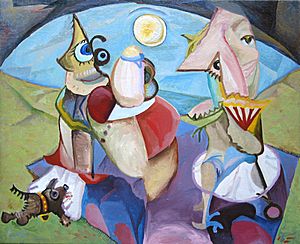Edwin G Lucas facts for kids
Quick facts for kids
Edwin George Lucas
|
|
|---|---|

Self Portrait, 1948
|
|
| Born | 30 March 1911 |
| Died | 9 December 1990 |
Edwin G Lucas (born March 30, 1911 – died December 9, 1990) was a Scottish artist. He created unique and imaginative Modernist paintings. Even though he was mostly self-taught, his Surrealist artworks from 1939 to 1952 were very special. They were unlike anything else seen in Scottish art at that time.
For many years, his art wasn't well known. But in 2013, curators at the Scottish National Gallery of Modern Art "discovered" his work. Since then, his paintings have started to get the attention they deserve.
Early Life and Art
Edwin George Lucas was born in Leith, Scotland, in 1911. He grew up in Juniper Green, a small village near Edinburgh. He went to Juniper Green Primary School and then George Heriot's School.
Edwin wanted to be an artist. However, his family encouraged him to choose a different path. This was because his uncle, E G Handel Lucas, who was also an artist, had a hard time making a living. So, Edwin joined the Civil Service in Edinburgh. He also studied at the University of Edinburgh and became a lawyer in 1934.
Throughout the 1930s, Edwin painted traditional landscapes. Most of these were watercolours. They often showed the countryside around his home in Juniper Green. His paintings were sometimes shown at exhibitions by the Society of Scottish Artists and the Royal Scottish Academy.
One of his paintings even caught the eye of a French art magazine. The magazine praised him as a "highly educated artist" with "great clarity and simplicity." They also noted his "freedom of spirit and stylistic versatility." These qualities became very important in his later, more unique artwork.
Surrealism and Unique Style
In the late 1930s, Surrealist art started to appear in Edinburgh exhibitions. Surrealism is an art style that uses dream-like images and strange combinations of objects. It explores the unconscious mind. Famous Surrealist artists like Salvador Dalí and Max Ernst had their works shown in Edinburgh. Edwin likely saw these exhibitions.
In 1939, Edwin started renting a studio. Soon after, he began painting Surrealist works himself. His first Surrealist painting is from August 1939. He later called this time a "flirtation with Surrealism." But it had a huge impact on his art. He developed his own special kind of Surrealism. His paintings from this time were truly unique in Scottish art. For example, his painting, Caley Station (1942), showed his own view of life at Edinburgh Princes Street railway station.
Post-War Art
During World War II, Edwin was a pacifist. This means he believed war was wrong and chose not to fight. Instead, he worked in hospitals. After the war, in 1944, he returned to Edinburgh. The years after the war were very creative for him. He went back to his job as a Civil Servant. But he also took evening classes at Edinburgh College of Art. He saw himself as a serious painter with a day job.
Patrick Elliott, a senior curator at the Scottish National Gallery of Modern Art, spoke about Edwin's work. He said that Edwin's paintings were "inexplicable" and unlike anything he had seen before. He noted that Edwin's style was very different from other Scottish painters of his time.
However, when Edwin painted these innovative works, they didn't get much attention. Unlike his landscapes, they were often not accepted for exhibitions. Edwin held his own shows in Edinburgh in 1950 and 1951. But these shows didn't receive much notice from the art world.
Later Life and Recognition
In 1952, Edwin married Marjorie Eileen McCulloch. They bought a house in Stockbridge, Edinburgh and had two sons. After his marriage, he stopped painting for a while. He painted again briefly in the 1980s. His eyesight got worse, which made it hard to paint. He passed away in 1990.
After his death, Edwin's family started to show his work. In 2009, they rented gallery space in Edinburgh for occasional exhibitions. But his art remained mostly unknown. Then, in 2013, a letter to the Scottish National Gallery of Modern Art changed everything. The gallery bought five of his paintings. These were displayed next to works by famous artists like Picasso.
Newspapers like The Daily Telegraph and The Times wrote stories about the "lost Surrealist" being discovered. This helped his work become more widely known.
Since then, Edwin's art has been shown in several exhibitions. The City Art Centre in Edinburgh included his work in two mixed shows. Two exhibitions were also dedicated only to his work at the Fine Art Society. His art was also part of a major exhibition at the Scottish National Gallery of Modern Art.
His recognition grew even more with a big solo exhibition. "Edwin G. Lucas: An Individual Eye" was shown at the City Art Centre in Edinburgh from August 2018 to February 2019. This exhibition is now traveling to other places, including the Beecroft Art Gallery in England.




